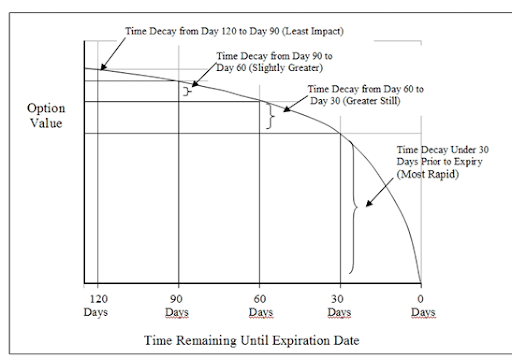How To Use Covered Calls To Your Advantage
Share

It’s a very dangerous and scary trying to catch a falling knife or a pick a bottom of any market, particularly this one. However, with the SPDR Trust (SPY) off some 25% and many individual stocks down 50% or more, it may be time for investors, especially younger ones with a longer term horizon, to start nibbling.
The rational approach is to use some form of dollar cost averaging, let’s say deploying 10-20% of your capital for every 5% decline in the overall market or individual stock’s price.
It also makes sense to employ an option strategy with the relatively high level of the VIX currently, which translates into pumped-up premiums across the options market.
Ready to join our Options360 trading community? Click HERE!
The covered call is one the most popular options strategies at a time like this, especially among investors that don’t necessarily consider themselves ‘option traders.’
It’s a way for people, particularly the buy and hold type, to generate income from the stocks they own. It also provides an immediate discount to the purchase price of shares from their current price.
Let’s look at a quick example using Microsoft (MSFT), which after getting smacked around following last night’s earnings report, is now down 32% from its 2021 highs.
With MSFT currently trading $230 per share, one could sell the December 250 strike calls for $5.50, meaning you’d collect $550 for every contract sold.
But remember, each option represents 100 shares, so a covered position would be a purchase of 100 shares of the stock vs. selling one call.
In this example, your cost basis for MSFT is immediately reduced to $224.50 or a 2.4% discount to the current price.
The 250 call is 13% out-of-the-money, meaning if shares were above 250 on the December 17 expiration date, you could have the shares ‘called away’ and realize a 12% gain in just 45 days.
Now that we have some math on a specific example, let’s drill down into the details of covered call.
When a trader writes a covered call, usually they are looking to sell time decay (Theta), a component of premium. They often will not consciously understand that, but when quizzed, that is generally their objective. Selling premium can mean many things, but in this context, we mean selling extrinsic value.
Extrinsic value is the component of an option price most influenced by time passing, the underlying symbol price changes, as do the buying and selling pressures of the option itself. Intrinsic value, the other component of an option price, is the actual value of the option at expiration; the real, tangible value. The intrinsic value is only a function of the underlying symbol price and the option type (call or put). The intrinsic value of an at-the-money or out-of-the-money option is zero.
Join us on our options trading journey HERE!
Near-term premium is what is most often sold. Here is a graph showing how the value of premium is not linear given time. An option will lose much less value over a day passing, when it is 60 days from expiring than when it is five days. The risk with covered call writing is that the underlying symbol will appreciate, causing the buyer of the option to exercise it, or worse, depreciate, leaving the seller with a premium against a devalued underlying symbol. Selling near-term premium optimizes the highest selling price with the least amount of time to wait for that price to decay. Our intention is to buy our call option back at a much lower price or let it expire worthless.
Note, time decay is not linear, it accelerates as the expiration date approaches.
The intention is to sell multiple cycles of premium against the underlying stock. Every cycle you sell premium against an underlying lowers your investment if it expires worthless.
If you want to be a part of the action, don’t delay join TODAY!
The profit of the previous cycle is subtracted from your investment. The profit of the current cycle over the lowered investment, exponentially increases your return on invested capital. Each subsequent cycle, you have a lower cost basis while collecting income of the option premium collected and dividends pay out.
You can learn about this options strategy, as well as the many, many more we use when you join the Options360 community. It is not only my goal to arm you with an arsenal of options strategies, but to demonstrate these in real time to build your confidence in executing these trades on your own.
If this sounds like something you are interested in, then I implore you to give Options360 a try with my one-month trial, which will be available to you for $19 for the first month. If you are not satisfied with the wealth of information this service makes available to you, cancel anytime and get your money back.
However, it is my firm belief you will get plenty of bang for your buck. Find out today!



